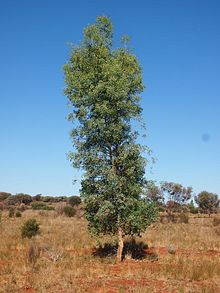Gyrostemonaceae
| Gyrostemonaceae | ||||||||||||
|---|---|---|---|---|---|---|---|---|---|---|---|---|

Gyrostemon ramulosus , illustration |
||||||||||||
| Systematics | ||||||||||||
|
||||||||||||
| Scientific name | ||||||||||||
| Gyrostemonaceae | ||||||||||||
| Final |
The Gyrostemonaceae are a family of plants in the order of the cruciferous (Brassicales). The 16 to 19 species are native to Australia including Tasmania (a species).
description

Vegetative characteristics
You grow as shrubs , small trees or sometimes semi-shrubs , the xerophytes are often somewhat succulent are. The secondary growth in thickness is based on a conventional cambium ring . The trunks and leaves are rubbery.
The alternate and spirally arranged leaves can be stalked or sessile and small to medium-sized. The simple, often fleshy or herbaceous to leathery leaf blades are linear, lanceolate, obovate or ovate. The leaf blades have only one leaf vein or there is pinnate veins . Tiny stipules may be present.
Generative characteristics
The flowers are solitary or in terminal or lateral, racemose or spike-like inflorescences. They are small bracts (Brakteolen) available.
The flowers are functionally unisexual, mostly on separate plant specimens ( diocyte ); the species are seldom single-sexed ( monoecia ). The inconspicuous flowers are more or less radial symmetry . The flower sleeve (Perianth) consists of a circle with four or five intergrown, sepal-like (sepalinen) bloom cladding that a wide fleshy, flat or convex flowers floor surrounded. The calyx is cup-shaped, lobed or entire. The 6 to 100 (numerous) stamens and the ovary are attached to this. The stamens are free from each other and also not fused with the bloom cladding sheets. There are extremely short stamens. The dust bags open with a longitudinal slit. The pollen grains have three apertures and are mostly colpat. 5 to 25 carpels are partially or completely fused to form an upper ovary. There is one anatropic ovule per carpel .
The mostly initially fleshy split fruits break up radially into 2 to 25 single-seeded partial fruits or closing fruits stand together in a collective fruit (syncarp). The seeds have an oily endosperm and a well-developed, curved embryo with two flat cotyledons ( cotyledons ).
Chromosome numbers and ingredients
The chromosome numbers are n = 14 or 15.
The mustard oil glycosides characteristic of the Brassicales order are present in this family .
ecology
The pollination is carried by the wind ( anemophily ).
Occurrence
The Gyrostemonaceae family is native to large areas of Australia and occurs throughout the continent , with the exception of the monsoon-affected north and southwestern Tasmania. However, the species only occur more frequently in arid areas. Some species are “fire opportunists” and colonize disturbed locations.
Systematics
The Gyrostemonaceae family is the sister group of the Resedaceae within the order of the cruciferous (Brassicales) .
In the family Gyrostemonaceae there are four to five genera with 16 to 19 species:
-
Codonocarpus A.
Cunn. ex Endl. : There are about three types:
- Codonocarpus attenuatus (Hook.) H. Walter
- Codonocarpus cotinifolius (Desf.) F. Muell.
- Codonocarpus pyramidalis (F.Muell.) F.Muell.
-
Cypselocarpus (F.Muell. Ex Benth.) F.Muell. : There is only one type:
- Cypselocarpus haloragoides (F.Muell. Ex Benth.) F.Muell. : It thrives on sandy soils in the coastal region of Western Australia .
- Gyrostemon Desf. (Syn .: Cyclotheca Moq. , Didymotheca Hook. F. ): There are about 12 or 13 types.
-
Tersonia Moq. : There is only one type:
- Tersonia cyathiflora (Fenzl) ASGeorge ex JWGreen : It is a perennial, ephemeral plant, the seeds of which survive in the seed bank for several years and only germinate after a fire. This endemic thrives on sandy soils north of Perth in Western Australia.
-
Walteranthus Keighery : There is only one species:
- Walteranthus erectus Keighery : It thrives on sand over limestone in the coastal region of Western Australia .
supporting documents
The article is based on the following web links:
- The family of gyrostemonaceae on the APWebsite. (Sections Description and Systematics)
- Gyrostemonaceae online at Flora of Australia . (Sections Description and Systematics)
- Gyrostemonaceae in L. Watson and MJ Dallwitz (1992 onwards): The families of flowering plants . (Section description)
- The Gyrostemonaceae family at Flora of Tasmania Online . (Sections Description and Systematics)
- The Gyrostemonaceae family at Western Australian Flora . (Section description)
- The Gyrostemonaceae Family at Flora of New South Wales Online . (Sections Description and Systematics)
Individual evidence
- ^ Codonocarpus at Australian Plant Name Index .
- ^ Australian Plant Name Index .
- ↑ Gyrostemon at Australian Plant Name Index .
- ^ Australian Plant Name Index .
- ↑ Katherine S. Downes, Byron B. Lamont, Marnie E. Light & Johannes van Staden: The fire ephemeral Tersonia cyathiflora (Gyrostemonaceae) germinates in response to smoke but not the butenolide 3-methyl-2H-furo [2,3-c ] pyran-2-one , In: Annals of Botany , Volume 106, Issue 2, 2010, pp. 381-384.
- ^ GJ Keighery: Walteranthus, a new genus of Gyrostemonaceae from Western Australia , In: Botanische Jahrbucher ... , Volume 106, 1, Engelmann Leipzig 1985.
- ^ Australian Plant Name Index .


